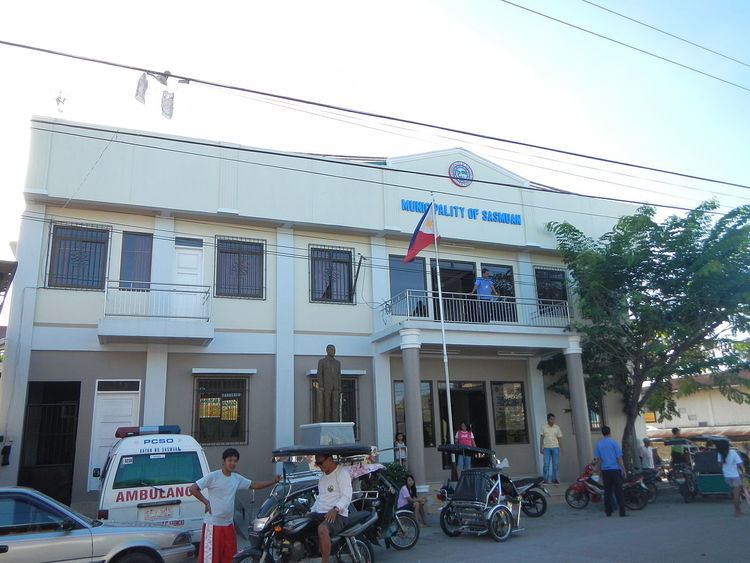Country Philippines Barangays ZIP code 2004 Population 27,254 (2010) Province Pampanga | District 2nd District Time zone PST (UTC+8) Area 91.8 km² Local time Thursday 9:34 AM Dialling code 45 | |
 | ||
Region Central Luzon (Region III) Weather 31°C, Wind N at 5 km/h, 62% Humidity Neighborhoods Malusac, San Nicolas 1st, San Pedro, Batang 2nd | ||
Project blue sasmuan pampanga
Sasmuan (known as Sexmoan until January 15, 1991) is a fourth class municipality in the province of Pampanga, Philippines. According to the 2010 census, it has a population of 27,254 people.
Contents
- Project blue sasmuan pampanga
- Map of Sasmuan Pampanga Philippines
- Etymology
- History
- Barangays
- Economy
- Cuisine
- Fiestas
- Santa Lucia Parish Church
- References
Map of Sasmuan, Pampanga, Philippines
Etymology
The town's former name of "Sexmoan" was how it was spelled by Spanish friars attempting to transcribe "Sasmuan". In Spanish, the letter <x> can be pronounced as a voiceless postalveolar fricative /ʃ/, identical to the digraph <sh> in English. It was derived from the ancient Kapampangan rootword sasmo, which means to meet, according to a 17th-century Kapampangan dictionary. Sasmoan therefore is synonymous with "pitagmuan" or "meeting place of the datus" or "meeting point". It was named "Sasmuan" because it is where the Pampangos meet when they were at war with the Chinese in Guagua. In 1991, it was unanimously changed into Sasmuan, since the previous name, Sexmoan, denoted a very negative sexual connotation not only to the town, but to the people living within the town itself due to the inculture of believing that the prefix Sex- had something to do with the english word sex.
History
Sasmuan already had a well-developed system of government well before the era of Spanish colonization. It evolved to be one of the oldest and major settlements in Pampanga by the 16th century. The Santa Lucia Church was one of the first Roman Catholic churches built in the Philippines by the Spaniards with the political and financial support of the Principalia.
Barangays
Sasmuan is politically subdivided into 12 barangays.
Economy
Sasmuan has a unique geography in that it is surrounded by fish ponds. Aquaculture has been the main industry that drives the local economy. The fish from ponds and other areas are sold at the Fish Port.
The town has 2 prime business ventures and both are in the food industry. These two are Sasmuan Delicacies which was founded in 1990 and Aiza's Sweets which was started in 2000. For Sasmuan Delicacies, their products are being sold in many big supermarkets and malls in the Philippines, including SM City Malls. Aiza's Sweets on the other hand, has SM City Malls as one of their primary customer, but they also sell to several popular local shops such as Susie's Sweets, Nathaniels, etc. Also, Aiza's Sweets exports to USA and Canada.
Cuisine
Fiestas
Santa Lucia Parish Church
The Santa Lucia Parish Church in Sasmuan is the first church in the province built by Augustinién priests. It stands right beside the Río Grande, the ancient waterway that connected Pampanga to Manila Bay. The structure is said to have been built by Jose Duque in the 17th century. It was rebuilt in early 1800 and was reinforced by Toribio Fanjul in 1884.
The edifice has an interesting and unique façade. It has decorative floral carvings on its main entrance. The old town church is one of the few, if not the only church in the country where the single belfry is situated between the church and the convento. The church, which measures 45 metres (148 ft) long, 11 metres (36 ft) wide, and 6 metres (20 ft) high, also features a grotto of Our Lady of Fatima. Devotees from all over the province flock here to honor Saint Lucy, believed to be a miraculous saint.
Founded in 1590, Santa Lucia is a parish of the Vicariate of St. Joseph in the Archdiocese of San Fernando. The parish celebrates the feast day of its titular patron on December 13.
An author described it as “very beautiful and of very good condition.” When looking at the complex of church and convent, one is stuck by the impression that the round and rectangular openings are capriciously aligned. This makes the façade both interesting and unique.
It was renovated in 2003 under parish priest Teodro P. Valencia. On June 9, 2007, it was solemnly rededicated.
